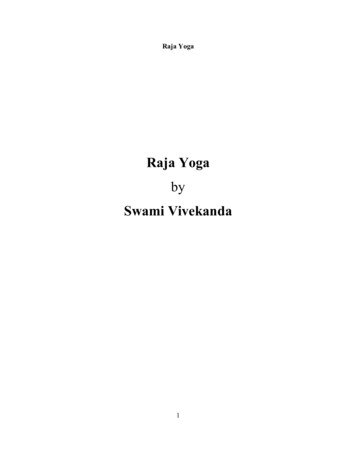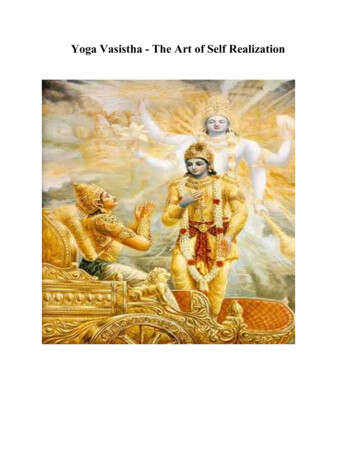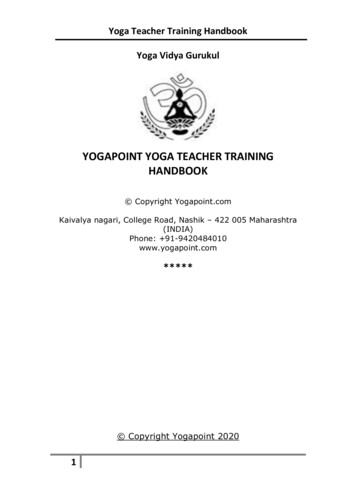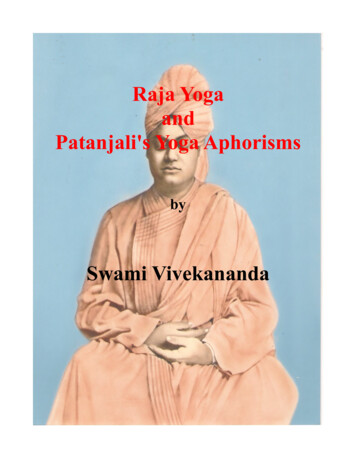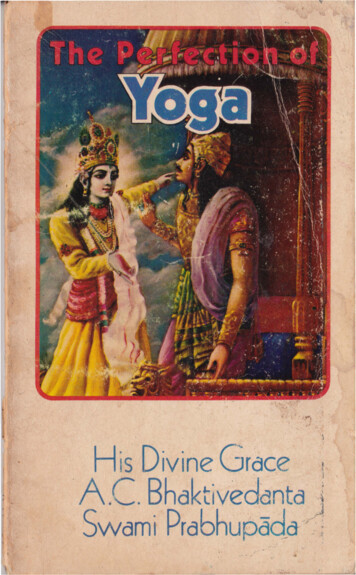
Transcription
lf. r
The Perfection of YogaHis Divine GrdceA.C. Bhdktiveddntd Swdmi Prdbhupddd'lFounder-Acarya of the International Society for Krishna Consciousness,.ISKCON Press, New York
ContentsI. Yoga as Reestablishing Relationswith Kr :va5II. Yoga as Work in Devotion12Ill. Yoga as Meditation on Kr J).aIV. Yoga as Rejected by Arjuna1622V. Yoga as Body and Mind Control28VI. Yoga as Freedom f rom Duality andDesignation45VII. The Fate of the Unsuccessful YogiVIII. The Perfection of Yoga4959ANNIE'S BOOK STOP§uat .:;:/fmz.7.ican fJ3uok Euhan'jl!""f){, Since 1974"'Yon·, ., N !V r V/,.:;ited A Book Store Likt' lt.".55 W. Main St. Bay Shore, NY 11706
,.j!@1972 by ISKCON PRESS. All rights reservedLibrary of Congress Catalogue Card N{). 72-76302ISBN 0-912776-36-6lIiReaders interested in the subject matter of thisbook are invited by the International Society forKrishna Consciousness to correspond with its Secretary.Internatiunal Society for Krishna Consciousness3826 Willat AvenuetCulver City, California 90230k .[First Printing: 30,000 copiesSecond Printing: 100,000 copies rJ !e,d i the Upit d. tqt s ? t. Am'8rica:j'
OTHER BOOKSby A.C. Bhaktivedanta Swami PrabhupadaB hagavad-gTta As It IsSrTmad-Bhagavatam, Cantos 1-3 (6 Vols.)Teachings of Lord CaitanyaThe Nectar of DevotionEasy Journey to Other PlanetsKr IJa Consciousness: The Topmost Yoga SystemKr IJa, The Supreme Personality of Godhead (2 Vols.)Transcendent ! Teachings of Prahlad MaharajTranscendental Teachings of Caitanya MahaprabhuBeyond Birth and DeathOn the Way to Kr IJaRaja-vidya: The King of KnowledgeElevation to Kr IJa ConsciousnessBack to Godhead Magazine (Founder)Srilsopani dComplt!tf! catalogue is available upon request fromISKCON BOOKS MAIL-ORDER3826 Willat A venueCulver City, Calif. 90230
1Yoga AsReestablishingRelations With Krsna.yoga system.yoga system is approved by Bhagavad-gitii, butyoga system in Bhagavad-gitii is especially meantWe have heard many times of theThethefor purification. The aim is threefold: to control thesenses, to purify activities and to link oneself toKr Q.a in a reciprocal relationship.The Absolute Truth is realized in three stages:impersonal Brahman, localized Paramatma (Super·soul)and ultimately asBhagavan, the SupremePersonality of Godhead. In the final analysis, theSupreme Absolute Truth is a Person, and simul·taneously He is the all-pervading Supersoul withinthe hearts of all living entities and within the coreof all atoms, and He is thebrahmajyotior theeffulgence of spiritual light as well. BhagavanSriKr Q.a is full of all opulence as the Supreme Person ality of Godhead, but at the same time He is fullof all renunciation. In the material world we findthat one who has much opulence is not very muchinclined to give it up, but Kr Q.a is not like this. Hecan renounce everything and remain complete inHimself.When we read or studyBhagavad-gitiiunder abona fide spiritual master we should not think thatthe spiritual master is presenting his own opinions.5
The Perfection of Yoga6It is not he who is speaking. He is just an instrument.The real speaker is the Supreme Personality of God head whoisboth within and without. At thebeginning of His discourse on the yoga system in the .Sixth Chapter of Bhagavad-gitii, Sri Kr Qa says:aniisrita karma-phalamkaryam karma karoti ya sa sannyiisi ca yogi cana niragnir na ciikriya "One who is unattached to the fruits of his workand who works as he is obligated is in the renouncedorder of life, and he is the true mystic; not he wholights no fire and performs no work." (Bg. 6.1)Everyone is working and expecting some result. Onemay ask what is the purpose of working if no resultis expected? A remuneration or salary is alwaysdemanded by the worker. But here Kr Qa indicatesthat one can work out of a sense of duty alone, notexpecting the results of his activities. If one works inthis way, then he is actually a sannyiisi; he is in therenounced order of life.According to Vedic culture, there are four stagesof life: brahmaciiri, grhastha, viinaprastha and sann yiisa. Brahmaciiri is student life devoted to trainingin spiritual understanding. Grhasth a life is marriedhouseholder life. Then upon reaching the approxi mate age of fifty, one may take the viinaprasthaorder-that is, he leaves his home and children andtravels with his wife to holy places of pilgrimage.Finally he gives up both wife and children and re mains alone to cultivate Kr Qa consciousness, and
Yoga as Reestablishing Relations with K.r J.la7that stage is called sannyiisa, or the renounced orderof life.Yet Kr qa indicates that for a sannyiisi,renunciation is not all. In addition, there must besome duty. What then is the duty for a sannyiisi, forone who has renounced family life and no longerhas material obligations? His duty is a most respon sible one; it is to work for Kr qa. Moreover, this isthe real duty for everyone in all stages of life.In everyone's life there are two duties: one is toserve the illusion, and the other is to serve the reality.When one serves the reality, he is a real sannyiisi.And when one serves the illusion, he is deluded bymiiyii. One has to understand, however, that he isin all circumstances forced to serve. Either he servesthe illusion or the reality. The constitutional pooitionof the living entity is to be a servant, not a master.Everyone in the material world is a servant; -no oneis master. One may think that he is the master, buthe is actually a servant. When one has a family hemay think that he is the master of his wife, or hischildren, or his home, business and so on, but thatis all false. One is actually the servant of his wife, ofhis children and of his business. The president maybe considered to be the master of the country, butactually he is the servant of the country. Our positionis always as servant-either as servant of the illusionor as servant of God. If, however, we remain theservant of the illusion, then our life is wasted. Ofcourse everyone is thinking that he is not a servant,that he is working only for himself. Although thefruits of his labor are transient and illusory, theyforce him to become a servant of illusion or a
8The Perfection of Yogaservant of his own senses. But when one awakens tohis transcendental senses and actually becomes situ ated in knowledge, he then becomes a servant of thereality. When one comes to the platform of knowl edge, he understands that in all circumstances he isa servant. Since it is not possible for him to bemaster, he is much better situated serving the realityinstead of the illusion. When one becomes aware ofthis, he attains the platform of real knowledge. Bysannyiisa, the renounced order of life, we refer toone who has come to this platform. Sannyiisa is aquestion of realization, not social status.Itis the duty of everyone to become Kr l}aconscious and to serve the cause of Kr Qa. When oneactually realizes this he becomes a mahiitmii, or agreat soul. In Bhagavad-gitii Kr l}a says that aftermany births, when one comes to the platform of realknowledge, he "surrenders unto Me." Why is this ?Viisudevaflsarvam iti. The wise man realizes that"Vasudeva [Kr lJa) is everything." However, Kr l}asays that such a great soul is rarely found. Why isthis? If an intelligent person comes to understandthat the ultimate goal of life is to surrender untoKr l}a, why should he hesitate? Why not surrenderimmediately? What is the point in waiting for somany births? When one comes to that point ofsurrender, he becomes a real sannyiisi. Kr q.a neverforces anyone to surrender unto Him. Surrender isa result of love, transcendental love. Where there isforce and where there is no freedom, there can beno love. When a mother lovesachild, she is notforced to do so, nor does she do so out of expecta tion of some salary or remuneration.
Yoga as Reestablishing Relations with Kr Q.a9Similarly, we can love the Supreme Lord in somany ways-we can love Him as master, as friend, aschild or as husband. There are five basic rasas orrelationphips in which we are eternally related toGod. When e are actually in the liberated stage ofknowledge, we can understand that our relationshipwith the Lord is in a particular rasa. That platformis called svarupa-siddhi, or real self-realization. Every one has an eternal relationship with the Lord, eitheras master and servant, friend and friend, parent andchild, husband and wife, or lover and beloved. Theserelationships are eternally present. The whole pro cess of spiritual realization and the actual perfectionof yoga is to revive our consciousness of this relation ship. At present our relationship with the SupremeLord is pervertedly reflected in this material world.Inthematerial world, the relationship betweenmaster and servant is based on money or force orexploitation. There is no question of service out oflove. The relationship between master and servant,pervertedly reflected, continues only for so long asthe master can pay the servant. As soon as the pay ment stops, the relationship also stops. Similarly, inthe material world there may be a relationshipbetween fri e nds, but as soon as there is a slightdisagreement, the friendship breaks, and the friendbecomes an enemy. When there is a difference ofopinion between son and parents, the son leaveshome and the relationship is severed. The same withhusband and wife; a slight difference of opinion,and there is divorce.·No relationship in this material world is actual oreternal.Wemustalwaysrememberthat these
10The Perfection of Yogaephemeral relationships are simply perverted reflec tions of that eternal relationship that we have withtheSupreme Personality ofGodhead. Wehaveexperience that the reflection of an object in a glassis not real. It may appear real, but when we go totouch it we find that there is only glass. We mustcome to understand thattheserelationships asfriend, parent, child, master, servant, husband, wifeor lover are simply reflections of that relationshipthat we have with God. When we come to this plat form of understanding, then we are perfect in knowl edge. When that knowledge comes, we begin tounderstand that we are servants of Kr IJ.a and thatwe have an eternal love relationship with Him.In this love relationship there is no question ofremuneration, but of course remuneration is there,and it is much greater than whatever we earn herethrough the rendering of service. There is no limit toSriKr l}a's remuneration. In this connection there isthe story of Bali Maharaja, a very powerful king whoconquered a number of planets. The denizens of theheavenly planets appealed to the Supreme Lord tosave them, for they had been conquered by thedemonic king, Bali Maharaja. Upon hearing theirpleas,SriKr l}a took the shape of a dwarf briihma[laboy and approached Bali Maharaja, saying, "My dearking, I would like something from you. You are agreat monarch and are renowned for giving in chari ty to the briihma[!as, so would you give me some thing?"Bali Maharaja said, "I will give you what youwant."
Yoga as Reestablishing Relations with Qall"I simply want whatever land I can cover in threesteps,'? the boy said."Oh, is that all?" the king replied. "And whatwill you do with such a small piece of land?""Though it may be small, it will suffice me," theboy smiled.Bali Maharaja agreed, and the boy dwarf tooktwo steps and covered the entire universe. He thenasked Bali Maharaja where he was going to take histhird step, and Bali Maharaja, understanding thatthe Supreme Lord was showing him His favor, re plied: "My dear Lord, I have now lost everything.I have no other property, but I do have my head.Would You so kindly step there?"Lord Sri Kr IJ.a was then very much pleased withBali Maharaja, and He asked, "What would youlike from Me?""I neverexpected·anything from You," BaliMaharaja said. "But I understand that You wantedsomething from me, and now I have offered Youeverything.""Yes," the Lord said, "but from My side I havesomething for you. I shall remain always as an order carrier servant in your court." In this way the Lordbecame Bali Maharaja's doorman, and that was hisreturn. If we offer something to the Lord, it is re turned millions of times. But we should not expectthis. The Lord is always eager to return the serviceof His servant. Whoever thinks that the service ofthe Lord is actually his duty is perfect in knowledgeand has attained the perfection of yoga.
2Yoga AsWork In DevotionWe have heard the names of so many differentyogas and yogis, but in Bhagavad-gitii Kr Qa saysthat he is the actual yogi who has surrendered him self "fully unto Me." Kr Qa proclaims that there isno difference between renunciation (sannyiisa) andyoga.yam sannyiisam iti priihuryogam tam viddhi par,ujavana hy asannyasta-sankalpoyogi bhavati kascana"What is called renunciation is the same as yoga, orlinking oneself with the Supreme; for no one canbecome a yogi unless he renounces the desire forsense gratification." (Bg.6.2)In Bhagavad-gitii there are three basic types ofyoga delin eated karma yoga, jiiiina-yoga and bhakti yoga. The systems of yoga may be likened unto a--staircase. Someone may be on the first step, some·one may be halfway up, or someone may be on thetop step. When one is elevated to certain levels, heis known as a karma-yogi, jiiiina-yogi, etc. In allcases, the service to the Supreme Lord is the same.It is a difference in elevation only. Thus Sri" K Qatells Arjuna that he must understand that renuncia·tion (sannyiisa) and yoga are the same because with out being freed from desire and sense gratificationone can become neitherayogi nor a sannyiisi.12
13Yoga as Work in DevotionThere are soine yogis who perform yoga for aprofit, but that is not real yoga. Everything must beengaged in the service of the Lord. Whatever we doasan ordinary worker, or as a sannyiisi, or as a yogi,or as a philosopher must be done in Kr Qa conscious·ness. When we are absorbed in the thought of servingKr lJa and when we act in that consciousness, we canbecome J:eal sannyiisis and real yogis.For those who are taking the first step up thestaircase of the yoga system, there is work. Oneshould not think that simply because he is beginningyoga that he should stop working. In Bhagavad-gitiiKr lJa asks Arjuna to become a yogi, but He nevertells him to cease from fighting. Quite the contrary.Of course one may ask how a person may be ,a yogiand at the same time a warrior. Our conception ofyoga practice is that of sitting very straight with legscrossed and eyes half-closed staring at the tip of ournose and concentrating in this way in a lonely place.So how is it that Kr Qa is asking Arjuna to become ayogi and at the same time participate in a ghastlycivil war? That is the mystery of Bhagavad-gitii: onecan remain a fighting man and at the same time bethe highest yogi, the highest sannyiisi. How is thispossible? In Kr Qa consciousness. One simply has tofight for Kr Qa, work for Kr Qa, eat for Kr Qa, sleepfor Kr Qa and dedicate all activities to K rya. In thisway one becomes the highest yogi and the highestsannyiisi. That is the secret.In the Sixth Chapter of Bhagavad-gitii,SriKr ryainstructs Arjuna how to perform meditational yoga,but Arjuna rejects this as too difficult. How then is
14The Perfection of YogaArjuna considered to beagreat yogi? AlthoughKr r.Ja saw that Arjuna was rejecting the meditationalsystem, He proclaimed Arjuna to be the highest yogibecause "You are always thinking of Me." Thinkingof Kr Qa is the essence of all yoga systems-of thehatha, karma, jiiiina, bhakti or any other system ofyoga,sacrifice or charity.All the recommendedactivities for spiritual realization end in Kr Qa con sciousness, in thinking always of Kr Qa. The actualperfection of human life lies in being always Kr Qaconscious and always being aware of Kr Qa whileperforming all types of activities.In the preliminary stage one is advised to alwayswork for KI;sna. One must be always searching outsome duty or some engagement, for it is a bad policyto remain idle even for a second. When one actuallybecomes advanced through such engagements, thenhe may not work physically, but he is always engagedwithin by constantly thinking of Kr Qa. In the pre liminary stage, however, one is always advised toengage one's senses in the service of K &J1a. Thereare a variety of activities one can perform in servingKr Qa. The International Society for Krishna Con sciousness is intended to help direct aspirant devoteesin these activities. For those working in K s.11a con sciousness, there are simply not enough hours in theday to serve Kr Qa.There are always activities,engagements both day and night, which the studentof Kr Qa consciousness performs joyfully. That isthe stage of real happiness-constant engagementfor I\r&J1a and spreading K &'1a consciousness aroundthe world. In the material world one may become
Yoga as Work in Devotion15very tired if he works all the time, but if one worksin Kri?IJa consciousness, he can chant Hare Kpmaand engage in devotional service twenty-four hoursa d ay and never get tired. But if we vibrate somemundane vibration, then we soon become exhausted.There is no question of becoming tired on the spiri tual platform. The spiritual platform is absolute. Inthe material world everyone is working for sensebrratification.Theprofitsofone'slaborin thematerial world are used to gratify one's senses. Butareal yogi: does not desire such fruits. He has no de sire other than KJ; qa, and KJ; I).a is alread y there.
3YogaAsMeditation On Krsna.In India there are sacred places where yogis go tomeditate in solitude, as prescribed in Bhagavad-gitii.Traditionally, yoga cannot be executed in a publicplace, but insofar as kirtana-mantra-yoga, or theyoga of chanting the Hare Kr l}a mantra: Hare Krrma,Hare K a, K a .Kr l)a, Hare Hare/Hare Rama,Hare Rama, Riima Riima, Hare Hare-is concerned,the more people present, the better. When LordCaitanyaMahiiprabhu was performing kirtana inIndia some five hundred years ago, He organized ineach group sixteen persons to lead the chanting,and thousands of persons chanted with them. Thisparticipation in kirtana, in the public chanting ofthe names and glories of God, is very possible and isactually easy in this age; but as far as the medita tional process of yoga is concerned, that is very diffi cult. It is specifically stated in Bhagavad-gitii that toperform meditational yoga one should go to a se cluded and holy place. In other words, it is necessaryto leave home. In this age of overpopulation it is notalways possible to find a secluded place, but this isnot necessary in bhakti-yoga.In the bhakti-yoga system there are nine differentprocesses: hearing, chanting, remembering, serving,worshiping the Deity in the temple, praying, carrying ·out orders, serving Kr l}a as friend and sacrificing forHim. Out of these, srava[Lam k1rtanam, hearing and16
Yoga as Meditation on KJ;eQ.al7chanting, are considered the most important. At apublic kirtana one person can chant Hare Kr1?1}a,1-lar·e Kr1?lJa, Kr1?lJa Kr1?lJa, Hare Hare/ Hare Rama,llare Rama, Rama Rama, Hare Hare, while a grouplistens, and at the end of the mantra, the group canrespond, and in this way there is a reciprocation ofhearing and chanting. This can easily be performedin one's own home, with a small group of friends orwith many people in a large public place. One mayaltempt to practice meditational yoga in a large cityor in a society, but one must understand that thisis one's own concoction and is not the methodrecommended in Bhagavad-gita.The whole process of the yoga system is to purifyoneself. And what is this purification? Purificationensues upon the realization of one's actual identity.Purification is realizing that"I am pure spirit-Jamnot this matter." Due to material contact, we areidentifying ourselves with matter, and we are think ing, "I am this body." But in order to perform realyoga one must realize his constitutional positionasl1eing distinct from matter. The purpose of seekingout a secluded place and executing the meditationalprocess is to come to this understanding. It is notpossible to come to this understanding if one exe wtes the process improperly. In any case, this is theconsideration of Lord Caitanya Mahaprabhu:harer nama harer namaharer namaiva kevalamkalau nasty eva nasty evanasty eva gatir anyathii
18The Perfection of Yoga"In this age of quarrel and disagreement [Kali-yuga],there is no other way of spiritual realization but thischanting of the names. There is no other way, thereis no other way, there is no other way."It is generally thought, at least in the Westernworld, that the yoga system involves meditating onthe void. But the Vedic literatures do not recom mend meditating on any void. Rather, the Vedasmaintain that yoga means meditation on Vi l)u, andthis is also maintained in Bhagavad-gitii. In manyyoga societies we find that people sit cross-leggedand very straight, then close their eyes to meditate,and so fifty percent of them go to sleep becausewhen we close our eyes and have no subject matterfor contemplation, we simply go to sleep. Of coursethis is not recommended by Sri K.r qa in Bhagavad gitii. One must sit very straight, and the eyes be onlyhalf-closed, gazing at the tip of one's nose. If onedoes not follow the instructions, the result will besleep and nothing more. Sometimes, of course, medi tation goes on when one is sleeping, but this is notthe recommended process for the execution of yoga.Thus to keep oneself awake Kr l)a advises that onealways keep the tip of the nose visible. In addition,one must be always undisturbed. If the mind isagitated, or if there is a great deal of activity goingon, one will not be able to concentrate. In medi tational yoga one must also be devoid of fear. Thereis no question of fear when one enters spiritual life.And one must also be brahmaciiri, completely freefrom sex life. Nor can there be any demands on onemeditating in this way. When there are no demands,
Yoga as Meditation on Kl; Qa19and one executes this system properly, then he carfcontrol his mind. After one has met allall the require ments for meditation, he must transfer his wholethought to Kr r,ta or Vi 1 1u. It is not that one is tolransfer his thought to vacancy. Thus Kr r.ta sayslhat one absorbed in the meditational yoga systemis "always thinking of Me."The yogi obviously has to go throughthrough a great dealdealof difficulty to purify the iitmii (mind, body andsoul), but it is a fact that this can be done mosteffectively in this age simply by the chanting ofHare K rg1a, Hare K.rwa, Kn \la K.r pa, Hare Hare/Hare Rama, Hare Rama, Rama Rama, Hare Hare.Why is this? Because this transcendental sound vi bration is nondifferent from Him. When we chantllis name with devotion, then Kr r,ta is with us, andwhen Kr r,ta is with us, then what is the possibilityof remaining impure? Consequently, one absorbedin Kl;sna consciousness, in chanting the names ofKr r,ta and serving Him always, receives the benefitof the highest form of yoga. The advantage is thathe doesn't have to take all the trouble of the medi l.ational process. That is the beauty of Kr r,ta con sctousness.In yoga it is necessary to control all of the senses,and when all the senses are controlled, the mindmust be engaged in thinking of V i l).U. One becomespeaceful after thus conquering material life.jitiitmana[l prasiintasyaparamiitmii samiihita[lSltOfifla·SUkha-du{lkhe utathii miiniipamiinayo{l
The Perfection of Yoga20'I1:1'i·:"For one who has conquered the mind, the Supersoulis already reached, for he has attained tranquility."(Bg. 6. 7) This material world has been likened to agreat forest fire. As in the forest, fire may automati cally take place, so in this material world, althoughwe may try to live peacefully, there is always a greatconflagration. It is not possible to live in peace any '"where in the material world. But for one who istranscendentally situated-either by the meditationalyogaI!' II,,,systemorbythe empirical philosophicalmethod, or by bhakti-yoga-peace is possible. Allformsofyogaaremeantfortranscendentallife, but the method of chanting is especially effec tive in this age. Kirtana may go on for hours, and onemay not feel tired, but it is difficult to sit in lotusposition perfectly still for more than a few minutes.Yet regardless of the process, once the fire of mate rial life is extinguished, one does not simply experi ence what is called the impersonal void. Rather, asKr qa tells Arjuna, one enters into the supreme abode.yunjann evam sadiitmiinamyogi niyata-miinasaftsiintim nirvii{w-paramiimmat-samsthiim adhigacchatilil·'lp'l"By meditating in this manner, always controlling the" ''Ibody, mind and activities, the mystic transcendental !·1 ,iij'ist attains to peace, the supreme nirviir-a whichabides in Me." (Bg. 6.15) Kr qa's abode is not void.\l lIt is like an establishment, and in an establishmentthere is a variety of engagements. The successfulyogi actually attains to the Kingdom of God where
Yoga as Meditation on K{ 1,1a21lltere is spiritual variegatedness. The yoga processesurc simply ways to elevate oneself to enter into thatubode. Actually we belong to that abode, but, beingforgetful, we are put in this material world. Just as amadman becomes crazy and is put into a lunatic asy lum, so we, losing sight of our spiritual identity,becomeerazy and are put into this material world. Thus thematerial world is a sort of lunatic asylum, and we canc:asily notice that nothing is done very sanely here.Our real business is to get out and enter into theKingdom of God. In Bhagavad-g'ita Krg1a gives infor rnalion of this kingdom and also gives instructionsubout His position and our position-of what He isund what we are. All the information necessary isHCt forth in Bhagavad-g'ita, and a sane man will takeudvantage of this knowledge.
4Yoga AsRejected By ArjunaThere have been many yoga systems popularizedin the Western World, especially in this century, butnone of them have actually taught the perfection ofyoga. In the Bhagavad-gitii, Sri Kr Qa, the SupremePersonality of Godhead, teaches Arjuna directly theperfection of yoga. If we actually want to participatein the perfection of the yoga system, in Bhagavad gitii we will find the authoritative statements of theSupreme Person.It is certainly remarkable that the perfection ofyoga was taught in the middle of a battlefield. It was"taught to Arjuna, the warrior, just before Arjunawas to engage in a fratricidal battle. Out of senti ment, Arjuna was thinking, "Why should I fightagainst my own kinsmen?" That reluctance to fightwas due to A una's illusion, and just to eradicateijthat illusion, Sri Kr Qa spoke the Bhagavad-gitii tohim. One can just imagine how little time must haveelapsed while Bhagavad-gitii was being spoken. Allthe warriors on both sides were poised to fight, sothere was very little time indeed-at the utmost, onehour. Within this one hour, the whole Bhagavad-gitiiwas discussed, and Sri Kr Qa set forth the perfectionof all yoga systems to His friend Arjuna. At the endof this great discourse, Arjuna set aside his misgivingsand fought.However, within the discourse, when Arjuna heard22,,
Yoga as Rejected by ArjunaI he23explanation of the meditational system of yoga how to sit down, how to keep the body straight, howLo keep the eyes half-closed and how to gaze at theLip of the nose without diverting one's attention, allthis being conducted in a secluded place alone-hereplied:yo 'yam yogas tvayii prokta[tsiimyena madhusiidanaetasyiiharh na pasyiimicaiicalatviit sthitirh sthiriim"0 Madhusudana, the system of yoga which Youhave summarized appears impractical and unendur able to me, for the mind is restless and unsteady "(Bg. 6.33)This is important. We must always re member that we are in a material circumstancewherein at every moment our mind is subject toagitation. Actually we are not in a very comfortablesituation. We are always thinking that by changingour situation we will overcome our mental agitation,and we are always thinking that when we reach acertain point, all mental agitations will disappear.But it is the nature of the material world that wecannot be free from anxiety. Our dilemma is thatwe are always trying to make a solution to ourproblems, but this universe is so designed that thesesolutions never come.Not being a cheater, being very frank and open,Arjuna tells Kr Qa that the system of yoga which Hehas described is not possible for him to execute. Inspeaking toaddressesKr Qa, itHimasis significant that ArjunaMadhusudana,indicatingthat
24The Perfection of Yogathe Lord is the killer of the demon Madhu. It isnotable that God's names are innumerable, for He isoften named according to His activities. Indeed, Godhas innumerable names because He has innumerableactivities. We are only parts of God, and we cannoteven remember how many activities we engage infrom our childhood to the present. The eternal Godis unlimited, and since His activities are also unlimit ed, He has unlimited names. of which Kr Qa is a when, being Kr Qa's friend, he couldaddress Him directly as Kr Qa? The answer is thatA una considers his mind to be like a great demon,such as the demon Madhu. If it were possible forKr Qa to kill the demon called the mind, then A unawould be able to attain the perfection ofyoga."Mymind is much stronger than this demon Madhu,"Arjuna is saying. "Please, if You could kill him, thenit would be possible for me to execute thisyogasystem." Even the mind of a great man like Arjunais always agitated. As Arjuna himself says:cancalarh hi mana kr IJapramiithi balavad d[!lhamtasyiiharh nigraharh manyeviiyor iva sudu karam"For the mind is restless, turbulent, obstinate andvery strong, 0 K qa, and to subdue it is, it seems tome, more difficult than(Bg.controllingthewind."6.34)It is indeed a fact that the mind is a
I. Yoga as Reestablishing Relations with Kr :va 5 II. Yoga as Work in Devotion 12 Ill. Yoga as Meditation on Kr J).a 16 IV. Yoga as Rejected by Arjuna 22 V. Yoga as Body and Mind Control 8 VI. Yoga as Freedom from Duality and Designation 45 VII. The Fate of the Unsuccessful Yogi 49 VIII. The




